Autonomy on Trial
When discussing the arrival of autonomous workboats, many – especially those developing the technologies that enable them – say it’s is not a matter of if, but when. In fact, autonomous harbor tugs are already being put to the test in Singapore, where authorities hope to establish the technological infrastructure to enable fully autonomous ship operations. In the U.S., an autonomous vessel was shown to be able to respond to marine oil spills.
But is autonomy really the future? Several technology leaders in this space say yes, though they point out many important questions still need to be answered, especially surrounding insurance, legal and regulatory requirements. The International Maritime Organization (IMO), U.S. Coast Guard (USCG) and other regulatory authorities globally are working with classification societies and industry partners to develop clearly defined regulations that would apply to vessels operating at various stages of autonomy, but much still needs to be done.
And then there’s the questions pertaining to the future role of mariners in the dawn of marine autonomy. Will autonomous-enabled vessels put crews out of work? Not necessarily. Marine autonomy comes in many shapes and sizes, and autonomous does not necessarily mean unmanned. Autonomy can exist in different stages and degrees, from smart and automated to fully independent. In each case, crew will maintain their vital role on board, but they’ll be supported by technologies that aim to help them do their jobs in a safer and more efficient manner.
Concept of operations
Domenic Carlucci, Director - Machinery, Propulsion, Electrical & Controls, Corporate Technology, at classification society the American Bureau of Shipping (ABS), says workboats and other smaller vessels that often ply shorter, dedicated routes are most ripe for autonomous operations. In this sector, much of the technology being explored today aims to improve safety and crew assistance, with navigation being the primary function most are working on, he says. “Navigation is an area people are focusing on because the technologies have already been developed. Information and technology that has been developed in other industries like aircraft or automotive can be leveraged into the marine environment. At this point, it’s not so much technology development, it’s more technology application.”
Carlucci adds it’s important to differentiate between autonomous functionality and manning levels. “Autonomous does not mean unmanned, and unmanned does not necessarily mean autonomous. Each vessel will have a concept of operations that will define how the vessel is managed and operated and each of the conditions and modes of operations that the vessel will be in.”
A vessel works in several periods of operations – in port, maneuvering, at sea, on station, standby, etc. – and each has potential for autonomous functionality to be utilized, yet other cases might require more human direct engagement, Carlucci explains. “Right now, much of the autonomous development is focused on the crews still being there and autonomy simply aiding or augmenting the capabilities of the crew on board.”
 “Right now, much of the autonomous development is focused on the crews still being there and autonomy simply aiding or augmenting the capabilities of the crew on board.” - Domenic Carlucci (Photo: ABS)
“Right now, much of the autonomous development is focused on the crews still being there and autonomy simply aiding or augmenting the capabilities of the crew on board.” - Domenic Carlucci (Photo: ABS)
And that’s where companies like Sea Machines come into play. The firm has developed advanced remote and autonomous control technologies for workboats and other commercial surface vessels. Don Black, the company’s Vice President of Sales and Marketing, says, “Autonomy is not about taking people out of the loop. It’s about making them more effective and reducing risk.”
Black expects humans will remain in the picture for the foreseeable future, and technology will allow them to shift into roles that are more supervisory, tapping computer vision, sensor fusion and data collection to leverage expanded situational awareness and advanced pilot capabilities. “Autonomy, at this stage in the game, is really about situational awareness and sensors use. These need to be developed completely before you’re talking about true autonomy. In the meantime, there are things we can do that allow the pilot to have better situational awareness – what’s going on inside and outside of their boat – that allows them to execute on a mission. They can be sitting at the helm but not necessarily driving the boat. They can watch what’s going on and they can intervene.”
“If you can take some of the human risk elements out of the boat, it doesn’t mean you’re taking the humans out of it too. What you’re trying to do is make it less risk-prone,” Black says. “There’s no person that could possibly have 100% execution all of the time. Whereas when you look at it from a technology perspective, they’re always on and they never get tired. They can feed information and alerts to the pilots.”
“Look at what’s going on aboard a busy vessel – whether it’s a survey boat or a tug – there’s a lot of activity going on. What our systems help crews to do is focus on the activity that is most important to them, whether that’s external to the boat or looking off the tech, and simply managing or executing that mission,” Black says.
“At the end of the day, human senses have limitations. That’s the reason we have a lot of devices like radar, sonar, all the rest of it, on the boat in the first place. When we look at what we do, we’re bringing all that together and consolidating it and making it far more consumable via human. When you look at it from that perspective, there’s no workboat or any type of vessel that can’t take advantage of that.”
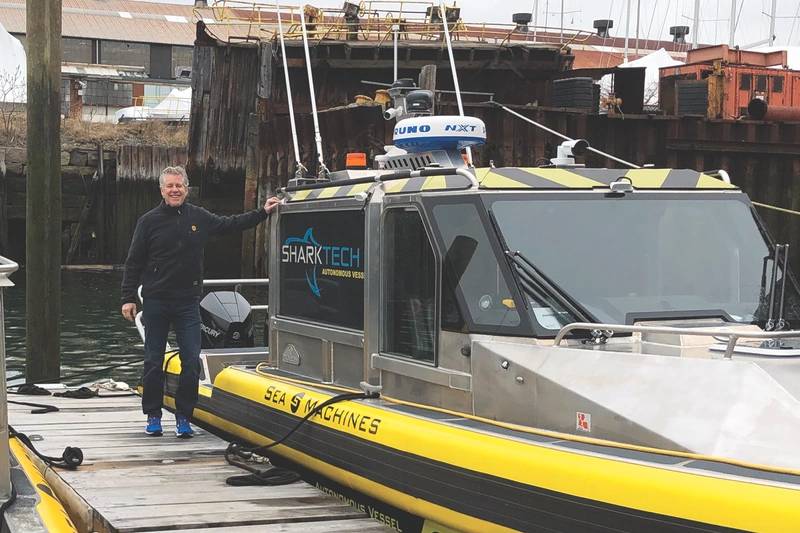 “If you can take some of the human risk elements out of the boat, it doesn’t mean you’re taking the humans out of it too.” - Don Black (Photo: Sea Machines Roobotics)
“If you can take some of the human risk elements out of the boat, it doesn’t mean you’re taking the humans out of it too.” - Don Black (Photo: Sea Machines Roobotics)
Putting the tools to use
In August 2019, Sea Machines demonstrated its SM300 vessel intelligence systems on board a Vigor/Kvichak Marine Industries-built skimmer boat in Portland harbor in Maine, as part of a cooperative agreement with the U.S. Department of Transportation Maritime Administration (MARAD). The vessel, owned by Marine Spill Response Corp. (MSRC), performed both autonomous and remote-controlled functionalities, overseen by an operator on land, with crew members on board ready to take control if necessary. Sea Machines demonstrated electronic navigational chart (ENC)-based mission planning, autonomous waypoint and grid line tracking, as well as collaborative autonomy for multi-vessel operations, and wireless remote payload control to deploy onboard boom, skimmer belt and other response equipment.
In a similar exercise one year earlier, Sea Machines demonstrated its SM300 in Denmark, on board an autonomous-command, remote-controlled fireboat owned by Tuco Marine. For both fireboats and spill response vessels, autonomous technology can free up crews to focus primarily on the difficult and dangerous emergency response task at hand, rather than navigating and performing other basic functions. Or, depending on the situation, humans could potentially be removed from the operation entirely to prevent exposure to hazardous conditions.
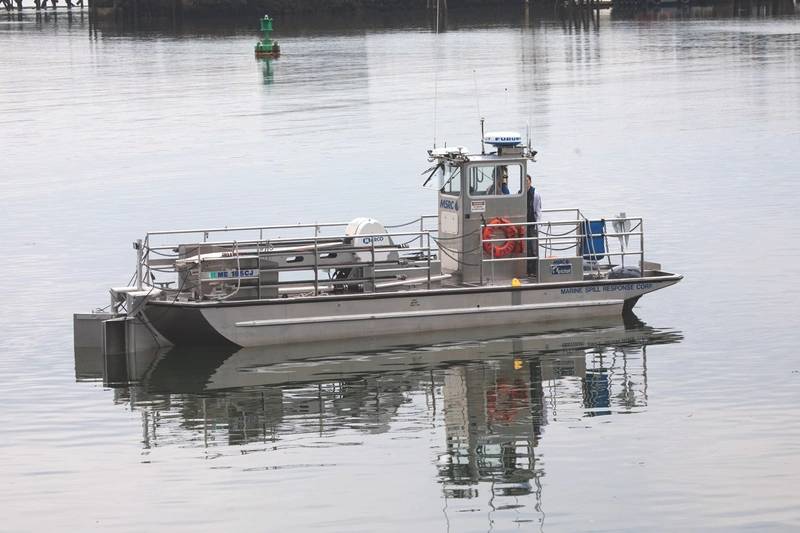 In August 2019, Sea Machines demonstrated a vessel equipped for autonomous marine oil spill response (Photo: Sea Machines)
In August 2019, Sea Machines demonstrated a vessel equipped for autonomous marine oil spill response (Photo: Sea Machines)
Elsewhere, places like Singapore and several areas in Northern Europe are pushing their locations to be autonomous testbeds, Carluccis says.
In the bustling Port of Singapore, which sees more than 130,000 vessels calling annually, technology company Wärtsilä is working with towage and pilotage service firm PSA Marine to further advance the capabilities of a harbor tug fit with dual azimuth thruster controls as well as a sensor suite, including Wärtsilä’s RS24 near-field high resolution radar and Wärtsilä’s dynamic positioning (DP) system, to enable autonomous capabilities. The vessel was recently put to the test as part of the IntelliTug project co-funded by the Maritime and Port Authority of Singapore’s (MPA) Maritime Innovation and Technology (MINT) Fund and involving classification society Lloyd’s Register and the Technology Center for Offshore and Marine Singapore (TCOMS).
The 27-meter harbor tug PSA Polaris has performed smart navigation and collision avoidance functions in real-life harbor trials, demonstrating its ability to steer clear of virtual and real-life moving vessels. Again, humans were on board and ready to take full control. The vessel’s smart navigation system allows the user to easily see the routes plotted, with the avoidance of collisions, in real-time, and sends track and speed commands to the DP system, which drives the vessel along the route safely at speeds up to 10 knots.
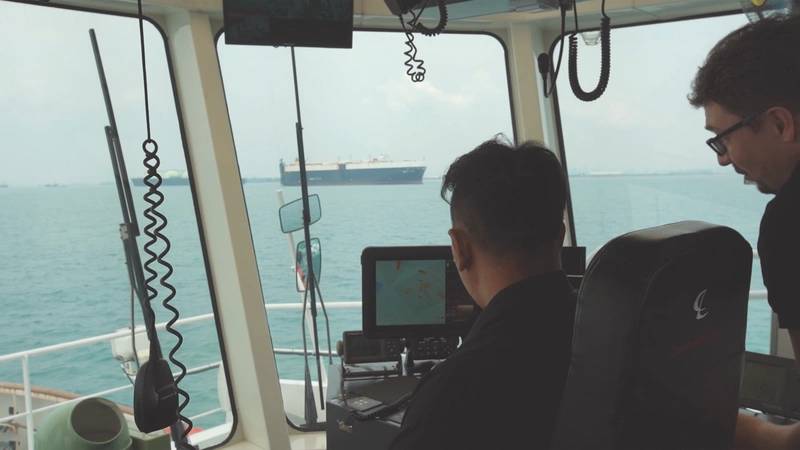 The 27-meter harbor tug PSA Polaris performed smart navigation and collision avoidance functions as part of real-world trials in the Port of Singapore (Photo: Wartsila)
The 27-meter harbor tug PSA Polaris performed smart navigation and collision avoidance functions as part of real-world trials in the Port of Singapore (Photo: Wartsila)
And there’s another group targeting autonomous harbor tug operations in Singapore by the end of 2020. Technology company ABB is working with Keppel Offshore & Marine’s technology arm, Keppel Marine and Deepwater Technology (KMDTech), as well as MPA and TCOMS, to develop autonomous vessel technologies for retrofit onto a 32-meter harbor tug. ABS will provide the Approval in Principle for the novel features such as remote navigation control and autonomous control system.
During the initial phase of the project, the vessel, operated by Keppel O&M’s joint-venture company Keppel Smit Towage, will complete a series of navigational tasks while being steered from an onshore control center. Later, during the project’s second phase, the vessel will perform autonomous collision avoidance tasks while under remote supervision. Pieces of ABB’s Ability Marine Pilot portfolio will provide sensor fusion from existing and new systems to generate digital situational awareness as well as execute commands. A third collaborative project in Singapore, between ST Engineering and PACC Offshore Services Holdings (POSH), ABS, MPA and TCOMS, will convert an existing manned tugboat into a smart autonomous vessel equipped with ST Engineering’s NERVA Ship Management System and Sensemaking System, which provides real time, centralized control and monitoring of shipboard systems, as well as condition-based maintenance.
Partners in each of the Singapore projects, like Sea Machines, stress the technology is not intended to remove crew, but to assist them. In the case of a harbor tug, for example, working vessels must sometimes make long transits to reach their destination. If a tug can perform this task autonomously, the crew on board would be able to rest before performing the hard work of pushing or towing other vessels.
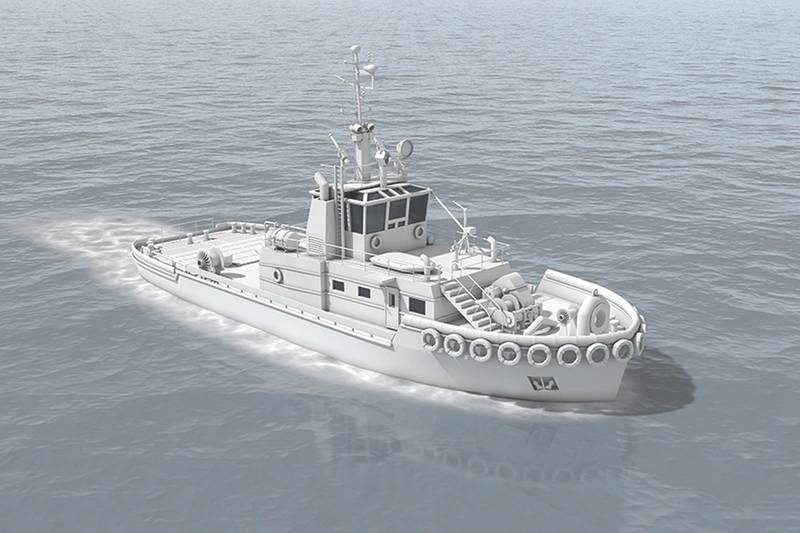 ABB is working with Keppel Offshore & Marine to develop autonomous vessel technologies for retrofit onto a 32-meter harbor tug for operations in Singapore. (Image: ABB)
ABB is working with Keppel Offshore & Marine to develop autonomous vessel technologies for retrofit onto a 32-meter harbor tug for operations in Singapore. (Image: ABB)
| In March, Abu Dhabi Ports announced it signed a Memorandum of Understanding with naval architect Robert Allan Ltd. to develop fully unmanned autonomous commercial marine tugs. The research and development project aims to deliver remotely-controlled vessels that will be fully unmanned and be able to operate within a wide spectrum of autonomy under Abu Dhabi Ports’ maritime service arm, SAFEEN. According to Abu Dhabi Ports, one of the main draws of the technology includes the capability to shift humans from on board to shore, allowing tugs to operate in far more adverse weather conditions. Autonomous vessels would also help to increase efficiency and enhance operational safety, it said. |
Regulatory catch-up
While the technology is being proven, efforts to firm up insurance, legal and regulatory requirements are still catching up. Black says only modest guidelines exist today, though there has been much progress toward addressing key issues. From a technology developer’s standpoint, he says, “Part of our challenges is not only to conform to what’s required, but also help to work with regulatory to help define those regulatory requirements so that technology can become available.”
Sea Machines is working alongside regulators and class with full confidence that acceptance and clear guideline on what is required will determined in a way that makes sense, Black says. “We look at it as a cooperative, non-antagonistic relationship. Everybody’s trying to get to the same end. Everybody knows it’s coming, but we all want to be prudent on how it’s adopted.”
Carlucci agrees progress is being made: “The regulatory landscape is changing and developing.”
At an international level, the IMO is in the midst of a scoping exercise where members and working groups are evaluating existing regulations (COLREGS, SOLAS, etc.) for potential impacts on autonomy, and determine whether existing rules need to be changed, rewritten or something new must be developed. “The impact of each existing regulation is being evaluated to see how autonomy will be addressed,” he says. “At a regional level, port states are evaluating how they’ll manage autonomy in their specific locales.”
“ABS has established rules and requirements over many years in areas like automation and software quality and cyber to build some of the foundational references and elements that will be needed to move and transition into an autonomous world,” Carlucci says. “We have published the ABS Advisory on Autonomous Functionality and are continuing work on our development of requirements for autonomy. They will build upon the foundational elements that smart systems has put in place. The primary focus is to maintain the safety of the vessel as the new technologies are applied.”
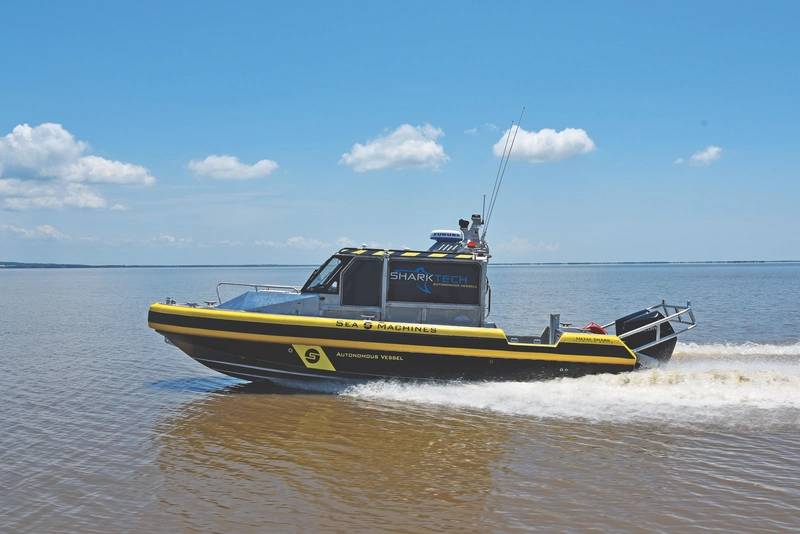 US shipbuilder Metal Shark, through a partnership with Sea Machines, has introduced a 29-foot autonomous vessel now being offered to government and commercial customers. The Sharktech 29 Defiant welded aluminum monohull pilothouse vessel features Sea Machines’ SM300 system. (Photo: Metal Shark)
US shipbuilder Metal Shark, through a partnership with Sea Machines, has introduced a 29-foot autonomous vessel now being offered to government and commercial customers. The Sharktech 29 Defiant welded aluminum monohull pilothouse vessel features Sea Machines’ SM300 system. (Photo: Metal Shark)















